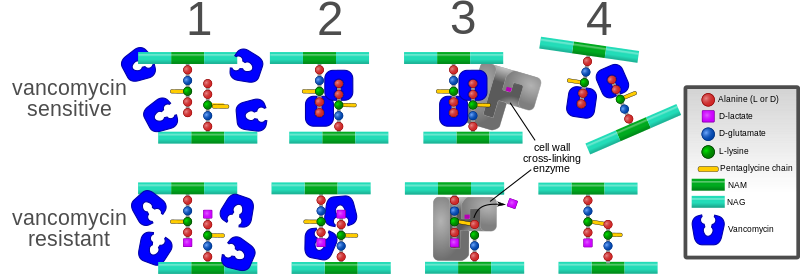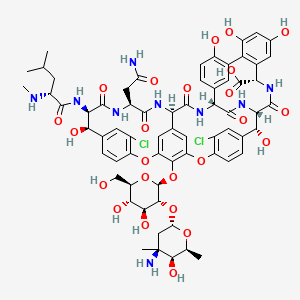Vancomycin is an antibiotic used to treat a number of bacterial infections. It is recommended intravenously as a first-line treatment for complicated skin infections, bloodstream infections, endocarditis, bone and joint infections, and meningitis caused by methicillin-resistant S. aureus. Blood levels may be measured to determine the correct dose. Vancomycin is also recommended by mouth as a treatment for severe Clostridium difficile colitis. When taken by mouth it is very poorly absorbed.
Scientists at The Scripps Research Institute (TSRI) have given new superpowers to a lifesaving antibiotic called vancomycin, an advance that could eliminate the threat of antibiotic-resistant infections for years to come. The researchers, led by Dale Boger, co-chair of TSRI’s Department of Chemistry, discovered a way to structurally modify vancomycin to make an already-powerful version of the antibiotic even more potent.
“Doctors could use this modified form of vancomycin without fear of resistance emerging,” said Boger, whose team announced the finding today in the journal Proceedings of the National Academy of Sciences.
About New Antibiotic Against Bacterial Resistance
The original form of vancomycin is an ideal starting place for developing better antibiotics. The antibiotic has been prescribed by doctors for 60 years, and bacteria are only now developing resistance to it. This suggests bacteria already have a hard time overcoming vancomycin’s original “mechanism of action,” which works by disrupting how bacteria form cell walls.
Boger called vancomycin “magical” for its proven strength against infections, and previous studies by Boger and his colleagues at TSRI had shown that it is possible to add two modifications to vancomycin to make it even more potent. “With these modifications, you need less of the drug to have the same effect,” Boger said.
The new study shows that scientists can make a third modification–which interferes with a bacterium’s cell wall in a new way–with promising results. Combined with the previous modifications, this alteration gives vancomycin a 1,000-fold increase in activity, meaning doctors would need to use less of the antibiotic to fight infection.
The discovery makes this version of vancomycin the first antibiotic to have three independent mechanisms of action. “This increases the durability of this antibiotic,” said Boger. “Organisms just can’t simultaneously work to find a way around three independent mechanisms of action. Even if they found a solution to one of those, the organisms would still be killed by the other two.”
Tested against Enterococci bacteria, the new version of vancomycin killed both vancomycin-resistant Enterococci and the original forms of Enterococci.
The next step in this research is to design a way to synthesize the modified vancomycin using fewer steps in the lab, as the current method takes 30 steps. But Boger calls this the “easy part” of the project, compared with the challenge of designing the molecule in the first place.
Even if the process isn’t streamlined, Boger believes the new vancomycin’s lifesaving powers make its production valuable. “Antibiotics are total cures for bacterial infections,” said Boger. “Making this molecule is important, even by the current approach, if the failure of antibiotics continues.”
About Vancomycin
Vancomycin is used to treat infections in many different parts of the body. It is sometimes given with other antibiotics. Vancomycin is also used in patients with heart valve disease (e.g., rheumatic fever) or prosthetic (artificial) heart valves who are allergic to penicillin. Under certain circumstances, this medicine also may be used to prevent endocarditis (inflammation of the lining of the heart) in these patients who are having dental work done or surgery on the upper respiratory tract (for example, nose or throat). Vancomycin also may be used for other conditions as determined by your doctor.
Vancomycin given by injection is used mainly for serious infections for which other medicines may not work. However, this medicine may cause some serious side effects, including damage to your hearing and kidneys. These side effects may be more likely to occur in elderly patients.


